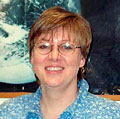 |
|
|
| Author |
Message |
Patty_Cie

Joined: 23 Mar 2004
Posts: 87

|
 Posted:
Sat Jun 19, 2004 9:53 pm Posted:
Sat Jun 19, 2004 9:53 pm |
  |
June 12, 2004 Saturday
4:00 PM Alaska time
Earlier this week a sign-up sheet was posted in the main lab to attend a guided tour of the Healy’s engine rooms. After listening and feeling the rumble and roar of the Healy these past weeks, I was curious to see the powerhouses that run the ship.
At the beginning of the tour, we were given an information pamphlet on the USCGC Healy. According to the pamphlet, the Healy, commissioned November 10, 1999, was named after Captain Michael A. Healy, a renowned Alaska seaman in the mid-1800’s. The ship’s primary mission is to “function as a world class high latitude research platform.” She is 420 feet long and 82 feet at her widest point. Her propulsion is diesel electric with AC/AC Cycloconverter. She can hold 1,220,915 gallons of fuel and travel up to 16,000 nautical miles at 12.5 knots. She has accommodations for 75 Coast Guard members, 50 scientists and 2 visitors. For more information about the Healy, please visit http://www.uscg.mil/pacarea/healy .
After a few minutes of looking over the pamphlet, we were taken to the ship’s storage areas. They are huge and they need to be. The Healy works in harsh, polar climates and must be self–reliant. There are holds with rows of cabinets containing thousands of spare parts. They must also store goods for the cruise and are capable of storing a year’s food for all onboard personnel.

The Healy is capable of storing a year’s supply of food.

LT Clarke explains the Healy carries her own replacement parts. They are stored in drawers like the ones behind him in this picture.
Soon we were into the bowels of the ship. We even were allowed to go down through a scuttle hole. I have obviously seen too many Hollywood movies because I expected cramped, oily spaces crawling with hot, greasy crew members. Instead, the areas were large and clean with only a few Coast Guard members doing maintenance.

Rachael Rearick is climbing through a scuttle hatch to enter the lowest deck.

EM1 Fratto and EM3 Haugk are doing routine maintenance on the Healy.
Redundancy is key for the Healy. Every system has at least one backup system. For example, there are four engines in two separate rooms. Fire is always a consideration on a ship. If there was a fire in one room, the Healy has backups to be able to continue functioning. LT Clarke, the engineer who gave the tour, showed us the escape routes for the personnel in case of fire. There are cameras in all spaces to see what is happening inside an area before entering. Safety is always first.

I am standing in front of generator number four. The Healy generates enough energy to power a small town.

Engineering has escape routes in case of fire.
Everything is clearly labeled and wiring is exposed so repairs can be made quickly. The main controls are in a temperature-controlled room located one floor above the engines and forward of the future lab (where I write my journals.) The engines are run by Coast Guard members and monitored by computers. There are approximately 30 engineers onboard.

The wiring is exposed for easy repair access.

Coast Guard members run the engines from the control room. Going left to right is EM1 Garrett, EMCM Mospens, DCC Schaffner, and ETCM Perron.

EM1 Pritchard was kind enough to explain to me in simple terms how the engines move the ship. As I understand it, the engines power the generators. The generators send 6600 volts to two high voltage switchboards. The switchboards send the power to transformers that step down the power to 1440 volts. The 1440 volts power the Cycloconverter drive that turns the motors. The motors turn the shafts and the shafts move the ship.
To see photographs taken by Steve Roberts of UCAR/JOSS, click here. |
|
|
    |
 |
|
|
|
View next topic
View previous topic
You cannot post new topics in this forum
You cannot reply to topics in this forum
You cannot edit your posts in this forum
You cannot delete your posts in this forum
You cannot vote in polls in this forum
You cannot attach files in this forum
You can download files in this forum
|
Powered by phpBB 2.0.11
© 2001, 2002 phpBB Group :: FI Theme ::
All times are GMT
| |
